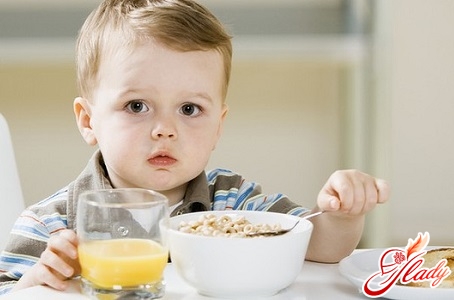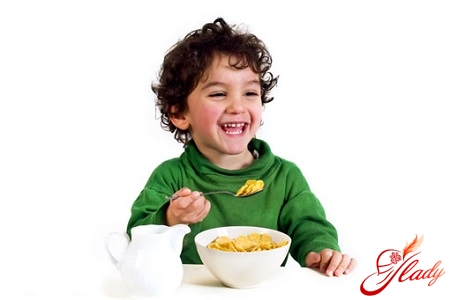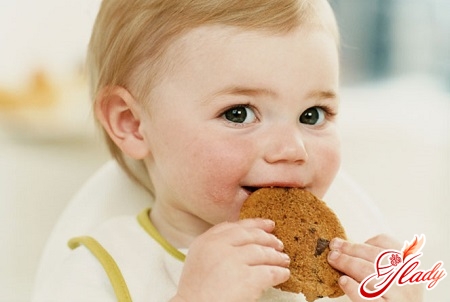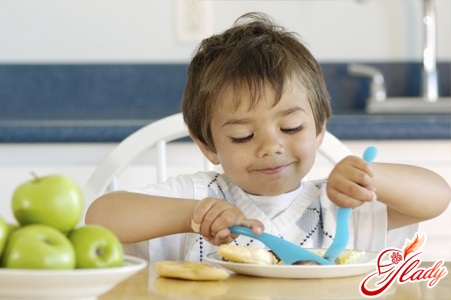
Due to the fact that children grow up quite quicklyand develop, young mothers have to adapt all the time. And in the child's diet, as it grows, changes occur. With each month, the child's digestive system improves, enzymatic activity increases, taste perception improves, the capacity of the stomach increases (which allows you to reduce the number of feedings, while increasing a single portion). By the end of the first year of life, children already have, as a rule, 6-8 teeth, which allows not only to swallow, but also to chew food. These factors make it possible to diversify the child's diet after a year. And to bring the child's food closer to the taste, consistency and composition of adult food.
Errors in the nutrition of children
Often when feeding children who have crossed the thresholdone-year mark, adults make typical mistakes. Some mothers of one-year-old babies immediately begin to feed them food intended for adults. Others continue to feed their children pureed food until 2-3 years of age. In both cases, the nutrition will be incomplete. The transition from breastfeeding and porridge food to full-fledged adult food should be gradual and include "transitional food". Since at the age of 1 to 2 years the chewing apparatus is not yet fully developed (at this age, as a rule, only chewing teeth begin to appear), the food should be soft, not hard and dry, but at the same time not be pureed. Meat is given to children from 1 to 1.5 years old ground, in the form of puddings, steamed cutlets. Vegetables and fruits are given finely grated. For older children (when molars begin to grow), it already makes sense to give food that requires active chewing.
Basic principles of nutrition
To ensure adequate nutrition for the childIt is necessary to observe the following principles. Food should be of high quality, meet caloric requirements and provide a daily supply of proteins, fats, carbohydrates, vitamins and mineral salts. Protein is the main building material. At this age, insufficient protein intake has an adverse effect on the growth and development of the child. The daily protein intake at the age of 1-3 years is 30-40 g per day. At the same time, 2/3 of the proteins should be of animal origin (meat, fish, eggs, dairy products), and a third of the proteins should be of plant origin (nuts, legumes). Fats are one of the sources of energy. Vitamins A, D, E and K are supplied with them (and are better absorbed). Easily digestible sources of fats are fish oil, fats contained in egg yolk, milk fats (butter, dairy products). Carbohydrates - participate in the metabolism of proteins and fats, are easily absorbed by the child's body. The daily norm of carbohydrates at the age of 1-3 years is about 130-200 g. The main sources of carbohydrates at this age should be cereals, fruits, vegetables, bread. You should be careful with sugar, because its excess negatively affects the health of the child. Vitamins - regulate metabolic processes in the body. Due to the huge impact they have on the health of the child, it is necessary to pay special attention to the quantity and quality of fruits and vegetables consumed daily by the child (since fruits and vegetables are the main sources of vitamins). Moreover, you should strive to ensure that the child's table contains vegetables and fruits that grow in the region where the child lives, and are appropriate for the season. Minerals - the building block of cells and tissue fluids, and at the same time they regulate metabolic processes. Minerals are contained in plant and animal foods, so it is necessary to diversify the child's diet with these products. Water. A child's body after one year consists of 85% water. A child's daily water requirement is about 90 ml per 1 kg of weight. In addition to water, at this age you can drink compotes, rosehip infusion, tea, and after one and a half years - cocoa.
What is the child's varied diet?
It can be concluded that the child needsprovide a rich and varied diet. It has been scientifically proven that when eating a combination of different foods, individual nutrients are absorbed better. A child's daily menu should consist of foods from 7 main groups: 1. Milk and dairy products. 2. Meat and meat products, fish, eggs. 3. Vegetable and dairy fats. 4. Bread, flour, cereals. 5. Legumes. 6. Vegetables. 7. Fruits. For a child's health, it is necessary that the daily diet include foods from all 7 groups. However, you should not think that you need to eat all of the listed foods every day. For example, meat should be excluded 2 times a week. It can be replaced with other foods containing animal proteins: eggs, dairy products, fish. This is considered a varied diet. A child should get used to a variety of foods and tastes at an early age, so that there is no taste preference for only a limited number of foods, since this entails the danger of monotonous and one-sided nutrition.
Child's diet after 1 year
The most complete absorption of nutrients,contained in food is possible only if a rational diet is followed. It provides a physiologically justified number of feedings during the day, the intervals between them. Special scientific studies have determined that the most optimal intervals for a child's body between feedings are at least 4 hours. If during this interval children receive any other food (candy, cookies, sweets, milk), then the excitability of the food center is inhibited, and by the next feeding the child loses appetite. The stomach is also freed from the food taken in at least 4 hours. With shorter intervals between feedings, the food taken in the previous and new feedings overfills the stomach, which has a very bad effect on digestion. Young children are recommended to follow a 4-time feeding regimen, combining this with other routine moments (sleep, games, walks). The most suitable feeding regimen for young children is a 4-meal regimen with a 4-hour interval between feedings and an even distribution of food between feedings, both in quantity and in the ratio of essential nutrients (proteins, fats, carbohydrates). Organizational aspects When feeding small children, it is necessary to provide a calm environment, directing all the child's attention to food. You cannot distract him with conversations, songs, games and force him to eat the amount of food that you think is optimal for him. At this age, you should instill in the child hygienic and cultural skills, teach him to eat independently. The food of a small child should be prepared from high-quality products. Food should be varied, pleasant to taste and have an attractive appearance, warm, should be served in beautiful children's utensils. All this stimulates the child's appetite. And everything that is eaten with appetite is absorbed much better.









